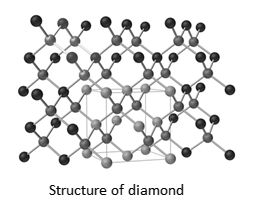
Diamond is a
A.solid containing hydrogen bonds
B.ionic solid
C.covalent solid
D.metallic solid
Answer
482.4k+ views
Hint: We must know that diamond and graphite both are the allotropes of carbon and so they have identical chemical properties. In diamond, each atom here shares the electrons with 4 other carbon atoms. Diamond is very strong in comparison to graphite as graphite exhibits a brittle and soft state. The sheets of carbon become bonded with weak covalent bonds during a tetrahedral structure. The other sheets of carbon become bonded by weak intermolecular forces. Due to the weak intermolecular forces, the layers of graphite can slide upon each other and make the substance very weak in comparison with diamonds. Also, diamond is difficult to break due to its giant covalent lattice and its many strong covalent bonds.
Complete step by step answer:
Diamond is a network covalent solid with no molecular boundaries.
Explanation:
Diamond is a naturally occurring mineral that is completely composed of only carbon atoms. Each carbon atom in a diamond is surrounded by four other carbon atoms and connected to one another by strong covalent bonds. Such an arrangement of covalently bound carbon atoms in the tetrahedral array makes the diamond structure the toughest substance.
Covalent bonds are the strongest type of chemical bond.
To break up the solid structure of a diamond, a lot of energy has to be forced to break the covalently bound strong \[C - C\] bonds. Diamond is a network solid and is a never-ending repetition of carbon atoms bonded to each other by covalent bonds.

As we can see in this above diagram, a perfect single crystal of a covalent solid of diamond thus makes a single giant molecule and it is a network covalent solid with no molecular boundaries.
Thus, Diamond is a covalent solid.
Hence, option C is the correct option.
Additional information:
1.The physical properties of diamond, melting point/boiling point, are so high as to be almost immeasurable due to the endless repetition of molecules in a structure of diamond.
2. As diamond is composed of the element carbon, it is falsely believed that it must have formed from coal and this is still taught in many classrooms. But it is not true.
Note:
We must know that the covalent solids are composed of a network of or chain of atoms or molecules that are held together by covalent bonds. Metallic solids are made up of metal cations that are held together by delocalized valence electrons with metallic bonds. Ionic solids are composed of positive and negative ions that are held together by electrostatic attractions.
Complete step by step answer:
Diamond is a network covalent solid with no molecular boundaries.
Explanation:
Diamond is a naturally occurring mineral that is completely composed of only carbon atoms. Each carbon atom in a diamond is surrounded by four other carbon atoms and connected to one another by strong covalent bonds. Such an arrangement of covalently bound carbon atoms in the tetrahedral array makes the diamond structure the toughest substance.
Covalent bonds are the strongest type of chemical bond.
To break up the solid structure of a diamond, a lot of energy has to be forced to break the covalently bound strong \[C - C\] bonds. Diamond is a network solid and is a never-ending repetition of carbon atoms bonded to each other by covalent bonds.

As we can see in this above diagram, a perfect single crystal of a covalent solid of diamond thus makes a single giant molecule and it is a network covalent solid with no molecular boundaries.
Thus, Diamond is a covalent solid.
Hence, option C is the correct option.
Additional information:
1.The physical properties of diamond, melting point/boiling point, are so high as to be almost immeasurable due to the endless repetition of molecules in a structure of diamond.
2. As diamond is composed of the element carbon, it is falsely believed that it must have formed from coal and this is still taught in many classrooms. But it is not true.
Note:
We must know that the covalent solids are composed of a network of or chain of atoms or molecules that are held together by covalent bonds. Metallic solids are made up of metal cations that are held together by delocalized valence electrons with metallic bonds. Ionic solids are composed of positive and negative ions that are held together by electrostatic attractions.
Recently Updated Pages
Glucose when reduced with HI and red Phosphorus gives class 11 chemistry CBSE

The highest possible oxidation states of Uranium and class 11 chemistry CBSE

Find the value of x if the mode of the following data class 11 maths CBSE

Which of the following can be used in the Friedel Crafts class 11 chemistry CBSE

A sphere of mass 40 kg is attracted by a second sphere class 11 physics CBSE

Statement I Reactivity of aluminium decreases when class 11 chemistry CBSE

Trending doubts
10 examples of friction in our daily life

Difference Between Prokaryotic Cells and Eukaryotic Cells

One Metric ton is equal to kg A 10000 B 1000 C 100 class 11 physics CBSE

State and prove Bernoullis theorem class 11 physics CBSE

What organs are located on the left side of your body class 11 biology CBSE

Define least count of vernier callipers How do you class 11 physics CBSE




